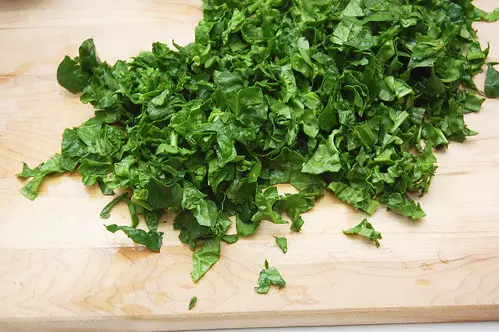Can iguanas eat spinach? If you own one of these big lizards, knowing what they can and can not eat is essential knowledge. Too many iguanas die prematurely because their owners feed them the wrong diet.
If you’ve ever seen Popeye the Sailor you’ll probably remember that whenever he ate spinach he grew huge muscles and became very strong – it pretty much gave him superpowers. Of course, this does not happen in real life, but it’s not that far from the truth. Spinach is very nutritious for humans. In fact, it’s one of the healthiest vegetables you can consume.
But does the same apply to iguanas? After all, they’re mostly herbivorous reptiles. Is spinach a good part of a healthy, balanced diet for these lizards? Can Iguanas even eat spinach in the first place?
The answer is not quite as straightforward as a simple yes or no. Iguanas can eat spinach, but only in small amounts once every other week. Spinach is full of nutrients that benefit these lizards, but since it contains oxalates, which bind to calcium and prevent absorption, it can’t be given to them too frequently. You can feed iguanas spinach either raw or cooked. Cooking will reduce the oxalate content but not every iguana might like to eat it that way.
To learn more about feeding this food to your iguana, keep reading and we’ll tell you everything you need to know.
Spinach nutrition

I’d like to start off by taking a look at what exactly is in spinach. That way we have an idea of the nutritional contents of this vegetable so we can see if there’s anything present that can harm our Iguana.
According to the USDA, 100 grams of raw spinach contains the following:
- 24 calories
- 2.35 grams of protein
- 3.53 grams of carbs
- 2.4 grams of fiber
- 0 grams of sugar
- 0 grams of fat
In addition, it also contains the following minerals and vitamins:
- Calcium
- Iron
- Magnesium
- Vitamin K
- Vitamin C
- Vitamin A
- Vitamin B9
- Potassium
- Sodium
- Oxalate
At first glance, the nutritional profile of spinach seems perfect for iguanas: low calories, low fat, low sugar with tons of fiber and minerals, and vitamins. And it would be if it wasn’t for one tiny detail: oxalate.
Oxalate, also known as oxalic acid, is an organic compound that is naturally found in many leafy greens and spinach is no exception. Let’s take a look at why it’s bad for iguanas.
Oxalate and iguanas – dangerous?

So, we’ve established that oxalate is present in spinach. However, that says very little if we don’t know what it does.
Oxalate is bad because it binds to calcium minerals. A result of this is a reduction of calcium levels in your iguana. These lizards need a relatively high amount of calcium in their diet, so it’s obviously not good that oxalate reduces their calcium levels.
But that is not all; it also forms the substance Calcium Oxalate which can cause blocking in the kidneys. This can lead to necrosis and eventually the death of your iguana (source).
Does this mean iguanas can not eat spinach at all?
Having read that, you’re probably thinking: There’s no way spinach can be a part of an iguanas diet if the oxalate in it can do that to them! But that’s not quite the case. It can still be a part of a healthy diet, but only if it’s fed to them very sporadically.
The amount of oxalate is luckily not very high in spinach. Other vegetables like rhubarb leaves contain way more oxalic acid and can therefore not be fed to your iguana at all. But spinach is okay to feed to them in small amounts and can be beneficial for them due to the nutrients presents in the vegetable.
How much spinach can iguanas safely eat?
The next question that naturally follows is the amount of spinach your iguana can eat without being negatively affected. According to the Animal Science Department at Cornell University, you can feed it to your iguana once every other week without adverse effects (source).
Feeding them only a small amount of spinach every other week will benefit their health, and you won’t have to worry about the effects oxalate will have on them.
How to feed spinach to iguanas?

Now you’re probably curious if you should cook the spinach, steam it or perhaps saute it? Luckily, feeding this leafy green to your iguana is very simple and you don’t need to be a chef to do it.
You can give spinach to your iguana raw – no cooking required. You should however chop it or dice it if you’re feeding a hatchling or juvenile iguana because their gut fauna can be overwhelmed by large pieces of food.
Also, since you’re feeding them raw spinach, it’s important that it’s properly washed to ensure that there are no pesticides present on the vegetable.
If you’re very concerned about the oxalic acid I’ve mentioned before, you’re better off steaming or boiling the spinach. A study has shown that steaming can reduce the amount of oxalate by 5-53% and boiling by 30-70% which is substantial (source).
If you’re wondering if you should feed them baby, or regular spinach – both are fine.
Alternative vegetables and fruits
Having read this, you might not want to feed spinach to your iguana, and that’s perfectly understandable. Luckily, there are plenty of other vegetables and fruits that you can give them. To get you started, here’s a quick list of ideas:
- Pineapple (occasionally)
- Zucchini
- Broccoli
- Kale
- Bok Choy
- Bell Peppers
- Cabbage
- Parsley
To learn more about what iguanas can eat, and to learn what foods are toxic to iguanas, I recommend that you check out this guide. It’ll teach you a lot of helpful information. For instance, did you know that iguanas can not eat oranges and avocado? Learning things like this is crucial to avoid feeding your pet the wrong foods.
- How Long Do American Eskimo Dogs Live? Important Factors and Care Tips - September 29, 2023
- Do American Bulldogs Need Grooming? Essential Tips and Care Guidelines - September 29, 2023
- Do Bengal Cats Enjoy Playing? Essential Tips for Keeping Them Active - September 29, 2023